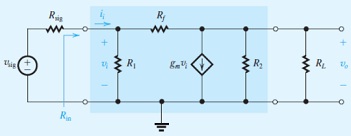Response to the following problem:
Most practical amplifiers have internal feedback that make them non-unilateral. In such a case, Rin depends on RL. To illustrate this point we show in Fig. the equivalent circuit of an amplifier where a feedback resistance
Rf models the internal feedback mechanism that is present in this amplifier. It is Rf that makes the amplifier non-unilateral. Show that

Evaluate Rin , Av o, and Ro for the case R1 = 100 kΩ , Rf = 1MΩ, gm= 100 mA/V, R2 = 100kΩ , and RL = 1 kΩ. Which of the amplifier characteristic parameters is most affected by Rf (that is, relative to the case with Rf =∞)? For Rsig = 100 kΩ determine the overall voltage gain, Gv , with and without Rf present.